Field Quality Control of Spectral Solar Irradiance Measurements by Comparison with Broadband Measurements
Abstract
:1. Introduction
- Spectroradiometers with a monochromator, which usually utilize a rotating diffraction grating. The rotating grating selects the wavelength to be displayed on a single sensor, e.g., a photomultiplier (PMT) or photodiode according to the wavelength to measure. Because of the operation procedure, they expend some minutes to take the measurements for a specific spectral range. The time necessary to complete a whole scan depends upon both the wavelength resolution and the spectral range of measurement, e.g., 10 min for some types of conventional high-quality spectroradiometers [1].
- Spectroradiometers with a fixed grating that projects the spectrum on a detector array, usually a photodiode or charge-coupled detector (CCD) array. No moving components are used in this category of spectroradiometers. They are faster-measuring because they measure the spectral irradiance at each wavelength at the same time. However, their measurements generally have a lower quality than the measurements taken with the other kind of spectroradiometers.
- A third class of spectroradiometers based on a Fourier transform can be found. They use a Michelson interferometer to measure how the signal of the interference oscillates by varying the path length travelled by light between two mirrors. The intensity of the spectrum is obtained with a further digital procedure. This class of spectroradiometers achieves the highest spectral resolution and allows the measurement of far-infrared spectra. This class of spectroradiometers was not considered in the present study.
2. Materials and Methods
2.1. Instrumentation and Atmospheric Radiative Transfer Codes
2.2. Quality Control Methodology Description
- Calculate the relative error between values of the integral of both the spectral measurement, , and the for the same spectral range.where is the relative error for the spectral range defined by the operating limits of the spectroradiometer or the spectral range of interest for the validation, and .
- A comparison of the shape of the two spectra on a graph by calculating the standard deviation,, of the subtraction of the two spectra, , and, if needed, by visual inspection.where N is the number of wavelengths () at which the sample has been measured.
2.3. Sensitivity Analysis Description
3. Results
3.1. Selection of Inputs and Times to Apply the QC
3.1.1. Sensitivity Analysis
3.1.2. When to QC
3.2. Applying the QC
4. Discussion
4.1. Results for Spect2
4.2. Results for Spect1
5. Conclusions
Author Contributions
Funding
Institutional Review Board Statement
Informed Consent Statement
Data Availability Statement
Acknowledgments
Conflicts of Interest
Nomenclature
| Symbol | Description and Units |
| AOD | aerosol optical depth (-) |
| G | global horizontal irradiance (W m−2) |
| G0 | extra-terrestrial broadband irradiance (W m−2) |
| G0λ | extra-terrestrial spectral irradiance (W m−2 nm−1) |
| Gb | beam normal irradiance or direct normal irradiance (W m−2) |
| Gb_rg | direct normal irradiance for a specific spectral range (W m−2) |
| Gbm | measured broadband direct normal irradiance (W m−2) |
| Gb_rgRef | direct normal irradiance value given for the standard conditions for the spectral range of interest (W m−2) |
| Gb_rgi | direct normal irradiance value varying the parameter i for the spectral range of interest (W m−2) |
| Gbλ | spectral beam normal irradiance or spectral direct normal irradiance (W m−2 nm−1) |
| Gbλe | estimated solar spectral irradiance (W m−2 nm−1) |
| Gbλm | measured spectral direct normal irradiance (W m−2) |
| Gd | diffusse horizontal irradiance (W m−2) |
| Gdλ | spectral diffusse horizontal irradiance (W m−2 nm−1) |
| Gλ | spectral global horizontal irradiance (W m−2 nm−1) |
| kT | clearness index (-) |
| m | air mass (-) |
| NIR | near-infrared spectral range (-) |
| P | pressure (kPa) |
| P0 | reference pressure at standard conditions, 100 (kPa) |
| rg | spectral range (-) |
| SeSλ | semi-empirical solar spectrum (W m−2 nm−1) |
| T | broadband atmospheric transmittance (-) |
| Taλ | spectral atmospheric transmittance due to aerosol extinction (-) |
| Tgλ | spectral atmospheric transmittance due to uniformly mixed gases (-) |
| Tnλ | spectral atmospheric transmittance due to NO2 (-) |
| Toλ | spectral atmospheric transmittance due to ozone (-) |
| TRλ | spectral atmospheric transmittance due to Rayleigh scattering (-) |
| Twλ | spectral atmospheric transmittance due to water vapour (-) |
| Tλ | spectral atmospheric transmittance (-) |
| TST | True solar time (h) |
| UV | Ultraviolet spectral range (-) |
| UVA | Ultraviolet-A spectral range (-) |
| UVB | Ultraviolet-B spectral range (-) |
| VIS | Visible spectral range (-) |
Greek Symbols
| Symbol | Description and Units |
| α | solar elevation (°) |
| λ | wavelength (nm) |
| σλ | standard deviation of the subtraction of solar spectra (W m−2 nm−1) |
| ΔGb_rg | broadband direct normal irradiance relative error for a defined spectral range (%) |
| ΔGb_th | threshold broadband direct normal irradiance relative error value (%) |
| ΔGb_sp | spectrorradiometer instrument relative error (%) |
| ΔGb_pyr | pyrheliometer instrument relative error (%) |
| σbb | standard deviation of the measured broadband direct normal irradiance for a time interval (W m−2) |
Acronyms and Abbreviations
| Symbol | Description |
| CCD | charge-coupled detector |
| CIEMAT | Centro de Investigaciones Energéticas, Medioambientales y Tecnológicas |
| METAS | Meteorological Station for Solar Technologies |
| DLR | Deutsches Zentrums für Luft- und Raumfahrt |
| PbS | lead sulphur |
| WMO | World Metheorological Organization |
| WRR | World Radiometric Reference |
References
- World Meteorological Organization. Guide to Meteorological Instruments and Methods of Observation; Chairperson Publications Board: Geneva, Switzerland, 2008; Volume 7, ISBN 978-92-63-10008-5. [Google Scholar]
- Marzo, A.; Ferrada, P.; Beiza, F.; Besson, P.; Alonso-Montesinos, J.; Ballestrín, J.; Román, R.; Portillo, C.; Escobar, R.; Fuentealba, E. Standard or local solar spectrum? implications for solar technologies studies in the atacama desert. Renew. Energy 2018, 127, 871–882. [Google Scholar] [CrossRef]
- Jessen, W.; Wilbert, S.; Gueymard, C.A.; Polo, J.; Bian, Z.; Driesse, A.; Habte, A.; Marzo, A.; Armstrong, P.R.; Vignola, F.; et al. Proposal and evaluation of subordinatestandard solar irradiance spectra for applications in solar energy systems. Sol. Energy 2018, 168, 30–43. [Google Scholar] [CrossRef]
- Wilbert, S.; Jessen, W.; Gueymard, C.; Polo, J.; Bian, Z.; Driesse, A.; Habte, A.; Marzo, A.; Armstrong, P.; Vignola, F.; et al. Proposal and evaluation of subordinate standard solar irradiance spectra with a focus on air mass effects. In Proceedings of the Solar World Congress 2017 (SHC2017), Abu Dhabi, United Arab Emirates, 29 October–2 November 2017; International Solar Energy Society: Freiburg, Germany, 2017; pp. 1–13. [Google Scholar]
- Marzo, A.; Beiza, F.; Ferrada, P.; Alonso, J.; Roman, R. Comparison of Atacama Desert Solar Spectrum vs. ASTM G173-03 Reference Spectra for Solar Energy Applications. In Proceedings of the EuroSun2016, Palma de Mallorca, Spain, 11–14 October 2016. [Google Scholar]
- Gueymard, C.A. SMARTS, A Simple Model of the Atmospheric Radiative Transfer of Sunshine: Algorithms and Performance Assessment; Florida Solar Energy Center: Cocoa, FL, USA, 1995. [Google Scholar]
- Kasten, F.; Young, A.T. Revised optical air mass tables and approximation formula. Appl. Opt. 1989, 28, 4735–4738. [Google Scholar] [CrossRef]
- Duffie, J.A.; Beckman, W.A. Solar Engineering of Thermal Processes; Wiley: New York, NY, USA, 2006; Volume 3. [Google Scholar]
- Mayer, B.; Kylling, A. Technical Note: The LibRadtran software package for radiative transfer calculations-description and examples of use. Atmos. Chem. Phys. 2005, 5, 1855–1877. [Google Scholar] [CrossRef] [Green Version]
- Anderson, G.P.; Kneizys, F.X.; Chetwynd, J.H.; Rothman, L.S.; Hoke, M.L.; Berk, A.; Bernstein, L.S.; Acharya, P.K.; Snell, H.E.; Mlawer, E.; et al. Reviewing atmospheric radiative transfer modeling: New developments in high and moderate resolution FASCODE/ FASE and MODTRAN. Opt. Spectrosc. Tech. Instrum. Atmos. Space Res. 1996, 2, 12. [Google Scholar] [CrossRef]
- Selby, J.E.A.; McClatchey, R.A. Atmospheric Transmittance from 0.25 to 28.5 Micrometers: Computer Code LOWTRAN 3; Air Force Cambridge Research Labs: Cambridge, MA, USA, 1975. [Google Scholar]
- Gueymard, C.A. Parameterized transmittance model for direct beam and circumsolar spectral irradiance. Sol. Energy 2001, 71, 325–346. [Google Scholar] [CrossRef]
- Dominec, F. Design and Construction of a Digital CCD Spectrometer; Czech Technical University in Prague, Faculty of Nuclear Sciences and Physical Engineering, Department of Physical Electronics: Prague, Czech Republic, 2010; Volume 34. [Google Scholar]
- Villemoes Andersen, H.; Wedelsbäck, H.; Hansen, P.W. NIR Spectrometer Technology Comparison. Available online: https://citeseerx.ist.psu.edu/viewdoc/download?doi=10.1.1.738.6676&rep=rep1&type=pdf (accessed on 20 June 2021).
- Martínez-Lozano, J.A.; Utrillas, M.P.; Pedrós, R.; Tena, F.; Díaz, J.P.; Expósito, F.J.; Lorente, J.; de Cabo, X.; Cachorro, V.; Vergaz, R.; et al. Intercomparison of Spectroradiometers for Global and Direct Solar Irradiance in the Visible Range. J. Atmos. Ocean. Technol. 2003, 20, 997–1010. [Google Scholar] [CrossRef] [Green Version]
- Polo, J.; Alonso-Abella, M.; Martín-Chivelet, N.; Alonso-Montesinos, J.; López, G.; Marzo, A.; Nofuentes, G.; Vela-Barrionuevo, N. Typical meteorological year methodologies applied to solar spectral irradiance for PV applications. Energy 2019, 116453. [Google Scholar] [CrossRef]
- Nofuentes, G.; Gueymard, C.A.; Caballero, J.A.; Marques-Neves, G.; Aguilera, J. Experimental evaluation of a spectral index to characterize temporal variations in the direct normal irradiance spectrum. Appl. Sci. 2021, 11, 897. [Google Scholar] [CrossRef]
- Guzzi, R.; Lo Vecchio, G.; Rizzi, R.; Scalabrin, G. Experimental validation of a spectral direct solar radiation model. Sol. Energy 1983, 31, 359–363. [Google Scholar] [CrossRef]
- Gueymard, C.A.; Myers, D.; Emery, K. Proposed reference irradiance spectra for solar energy systems testing. Sol. Energy 2002, 73, 443–467. [Google Scholar] [CrossRef]
- Peterson, J.; Vignola, F.; Habte, A.; Sengupta, M. Developing a spectroradiometer data uncertainty methodology. Sol. Energy 2017, 149, 60–76. [Google Scholar] [CrossRef]
- Choi, K.T.H.; Brindley, H.; Ekins-Daukes, N.; Escobar, R. Developing automated methods to estimate spectrally resolved direct normal irradiance for solar energy applications. Renew. Energy 2021, 173, 1070–1086. [Google Scholar] [CrossRef]
- Marzo, A.; Ballestrín, J. A realistic test for validate solar spectral measurements. In Proceedings of the SolarPACES 2010, Perpignan, France, 21–24 September 2010. [Google Scholar]
- CIEMAT. Plataforma Solar de Almería. Annual Report; CIEMAT: Madrid, Spain, 2013. [Google Scholar]
- GmbH, Instrument Systems. Spectro 320-Scanning Spectrometer; Instrument Systems: Berlin, Germany, 2011. [Google Scholar]
- Polo, J.; Zarzalejo, L.F.; Salvador, P.; Ramírez, L. Angstrom turbidity and ozone column estimations from spectral solar irradiance in a semi-desertic environment in Spain. Sol. Energy 2009, 83, 257–263. [Google Scholar] [CrossRef]
- Kipp & Zonen. V CHP1 Pyrheliometer Instruction Manual. Manual Version: 0811. C:2008. Available online: http://www.kippzonen.com/Download/202/CHP-1-Pyrheliometer-Manual?ShowInfo=true (accessed on 6 April 2015).
- Goswami, D.Y.; Kreith, F.; Kreider, J.F.; Kreith, F. Principles of Solar Engineering; Hemisphere Publishing Corp: Philadelphia, PA, USA, 2000. [Google Scholar]
- Louche, A.; Maurel, M.; Simonnot, G.; Peri, G.; Iqbal, M. Determination of Ångström’sturbidity coefficient from direct total solar irradiance measurements. Sol. Energy 1987, 38, 89–96. [Google Scholar] [CrossRef]
- Cañada, J.; Pinazo, J.M.; Bosca, J.V. Determination of angstrom’s turbidity coefficient at Valencia. Renew. Energy 1993, 3, 621–626. [Google Scholar] [CrossRef]
- Gueymard, C.A.; Gueymard, C.A. Turbidity Determination from Broadband Irradiance Measurements: A Detailed Multicoefficient Approach. J. Appl. Meteorol. Climatol. 1998, 37, 414–435. [Google Scholar] [CrossRef]
- Gueymard, C.A.; Vignola, F. Determination of atmospheric turbidity from the diffuse-beam broadband irradiance ratio. Sol. Energy 1998, 63, 135–146. [Google Scholar] [CrossRef]
- Salmon, A.; Quiñones, G.; Soto, G.; Polo, J.; Gueymard, C.; Ibarra, M.; Cardemil, J.; Escobar, R.; Marzo, A. Advances in aerosol optical depth evaluation from broadband direct normal irradiance measurements. Sol. Energy 2021, 221, 206–217. [Google Scholar] [CrossRef]
- Salmon, A.; Quiñones, G.; Soto, G.; Polo, J.; Gueymard, C.; Ibarra, M.; Cardemil, J.; Escobar, R.; Marzo, A. Advances in aerosol optical depth evaluation from broadband direct normal irradiance measurements. In Proceedings of the ISES Solar World congress SWC/SHC 2019, Santiago de Chile, Chile, 4–7 November 2019; International Solar Energy Society: Freiburg, Germany, 2019; pp. 2007–2016. [Google Scholar]
- American Society for Testing and Materials ASTM G173-03 Standard Tables for Reference Solar Spectral Irradiances: Direct Normal and Hemispherical on 37° Tilted Surface. Available online: https://www.astm.org/Standards/G173.htm (accessed on 9 September 2016).
- Wen, C.-C.C.; Yeh, H.-H.H. Comparative influences of airborne pollutants and meteorological parameters on atmospheric visibility and turbidity. Atmos. Res. 2010, 96, 496–509. [Google Scholar] [CrossRef]
- LeBaron, B.A.; Michalsky, J.J.; Harrison, L. Rotating shadowband photometer measurement of atmospheric turbidity: A tool for estimating visibility. Atmos. Environ. 1989, 23, 255–263. [Google Scholar] [CrossRef]
- Eltbaakh, Y.A.; Ruslan, M.H.; Alghoul, M.A.; Othman, M.Y.; Sopian, K. Issues concerning atmospheric turbidity indices. Renew. Sustain. Energy Rev. 2012, 16, 6285–6294. [Google Scholar] [CrossRef]
- Eltbaakh, Y.A.; Ruslan, M.H.; Alghoul, M.A.; Othman, M.Y.; Sopian, K.; Razykov, T.M. Solar attenuation by aerosols: An overview. Renew. Sustain. Energy Rev. 2012, 16, 4264–4276. [Google Scholar] [CrossRef]
- Badarinath, K.V.S.; Kharol, S.K.; Kaskaoutis, D.G.; Kambezidis, H.D. Influence of atmospheric aerosols on solar spectral irradiance in an urban area. J. Atmos. Sol. Terr. Phys. 2007, 69, 589–599. [Google Scholar] [CrossRef]
- Wuttke, S.; Seckmeyer, G.; Bernhard, G.; Ehramjian, J.; McKenzie, R.; Johnston, P.; O’Neill, M. New spectroradiometers complying with the NDSC Standards. J. Atmos. Ocean. Technol. 2006, 23, 241–251. [Google Scholar] [CrossRef]
- Cordero, R.R.; Damiani, A.; Seckmeyer, G.; Jorquera, J.; Caballero, M.; Rowe, P.; Ferrer, J.; Mubarak, R.; Carrasco, J.; Rondanelli, R.; et al. The solar spectrum in the atacama desert. Sci. Rep. 2016, 6, 22457. [Google Scholar] [CrossRef]
- Hollidge, A.; Seftor, C. Ozone & Air Quality. Available online: http://ozoneaq.gsfc.nasa.gov/ (accessed on 19 May 2021).
- Giles, D.M.; Holben, B.N. Aeronet. Available online: http://aeronet.gsfc.nasa.gov/ (accessed on 1 May 2021).
- Taha, G.; Yan, M.M.; McPeters, R.D. AURA, Validation Data Center. Available online: http://avdc.gsfc.nasa.gov/ (accessed on 19 May 2021).

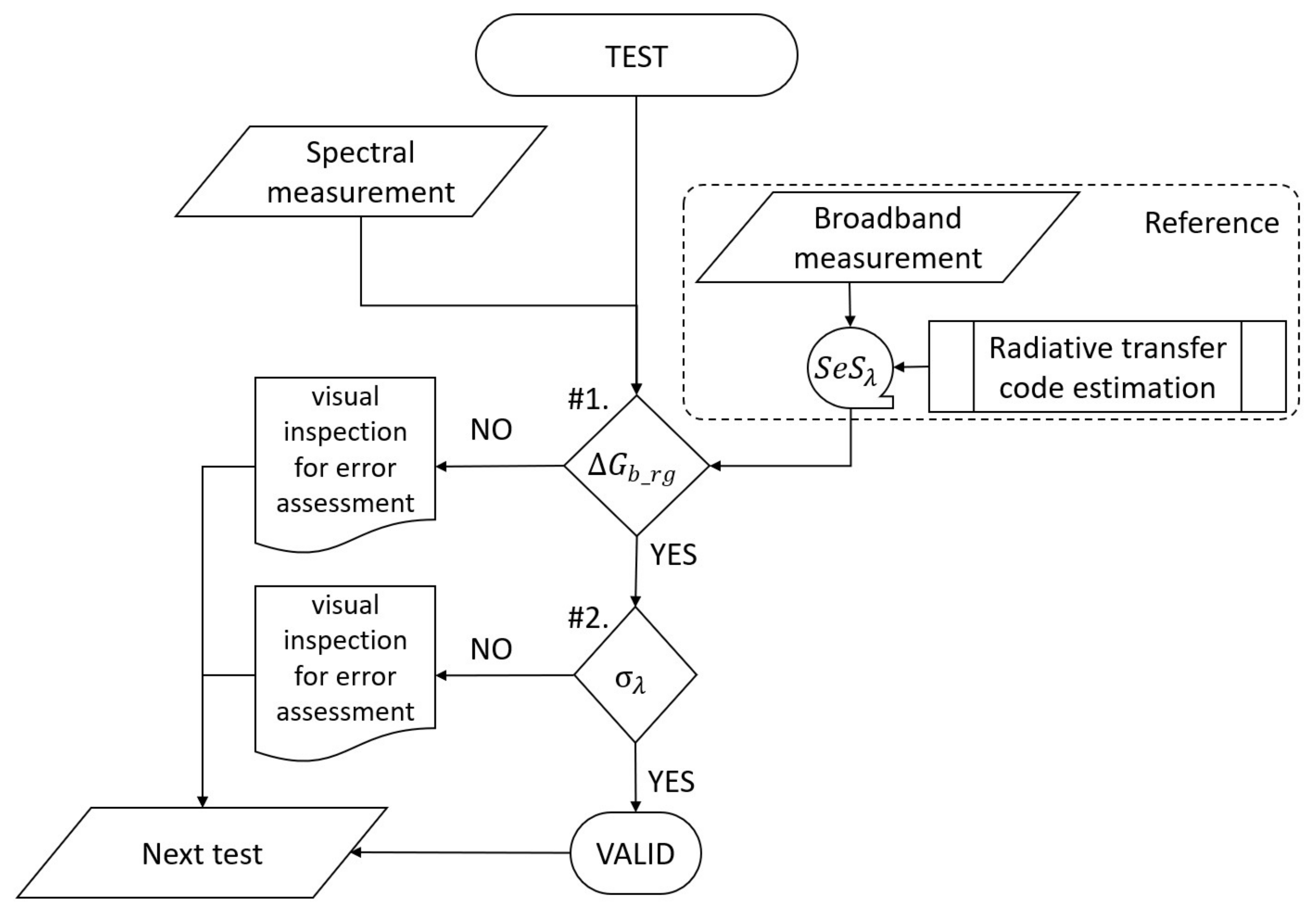
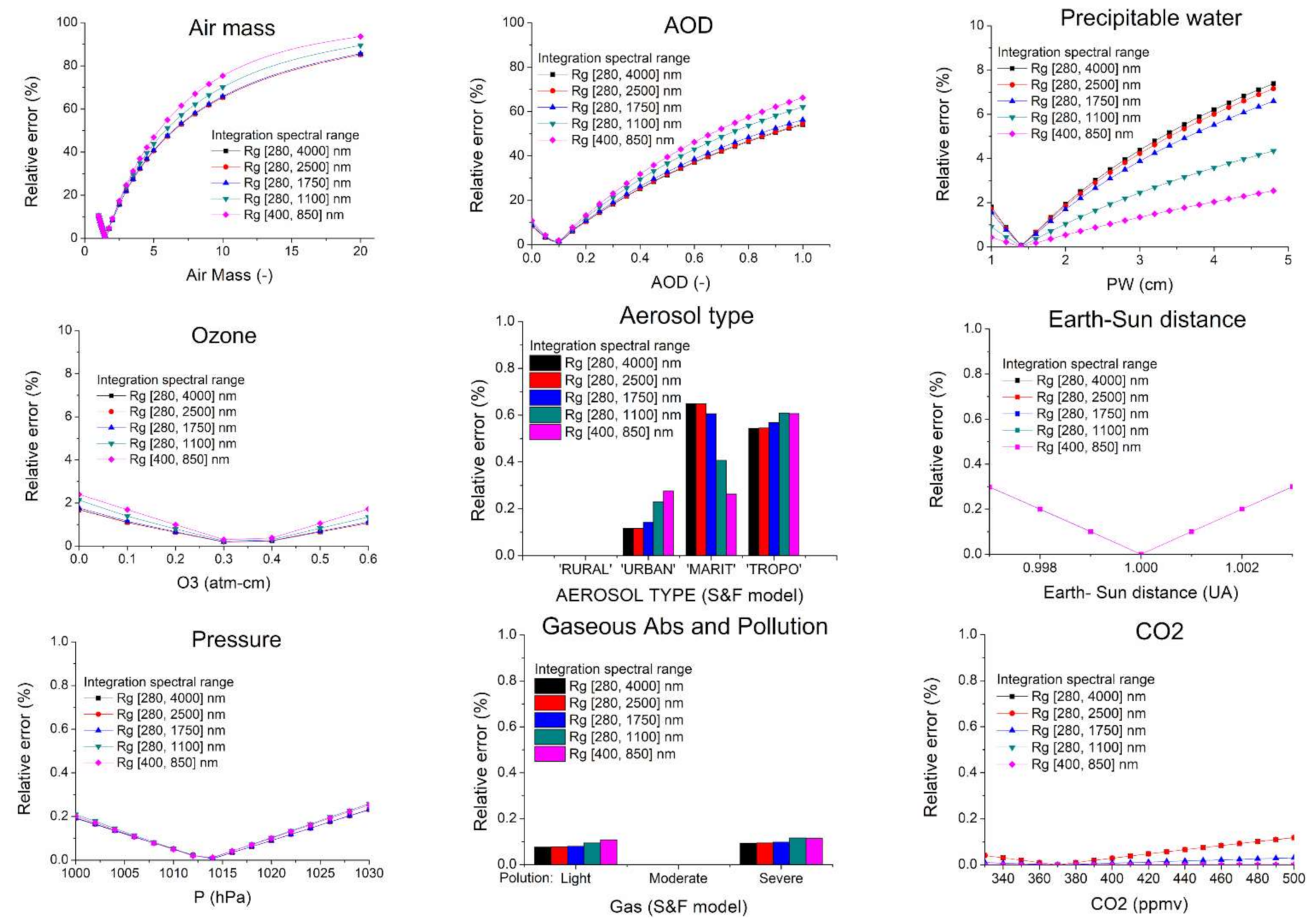
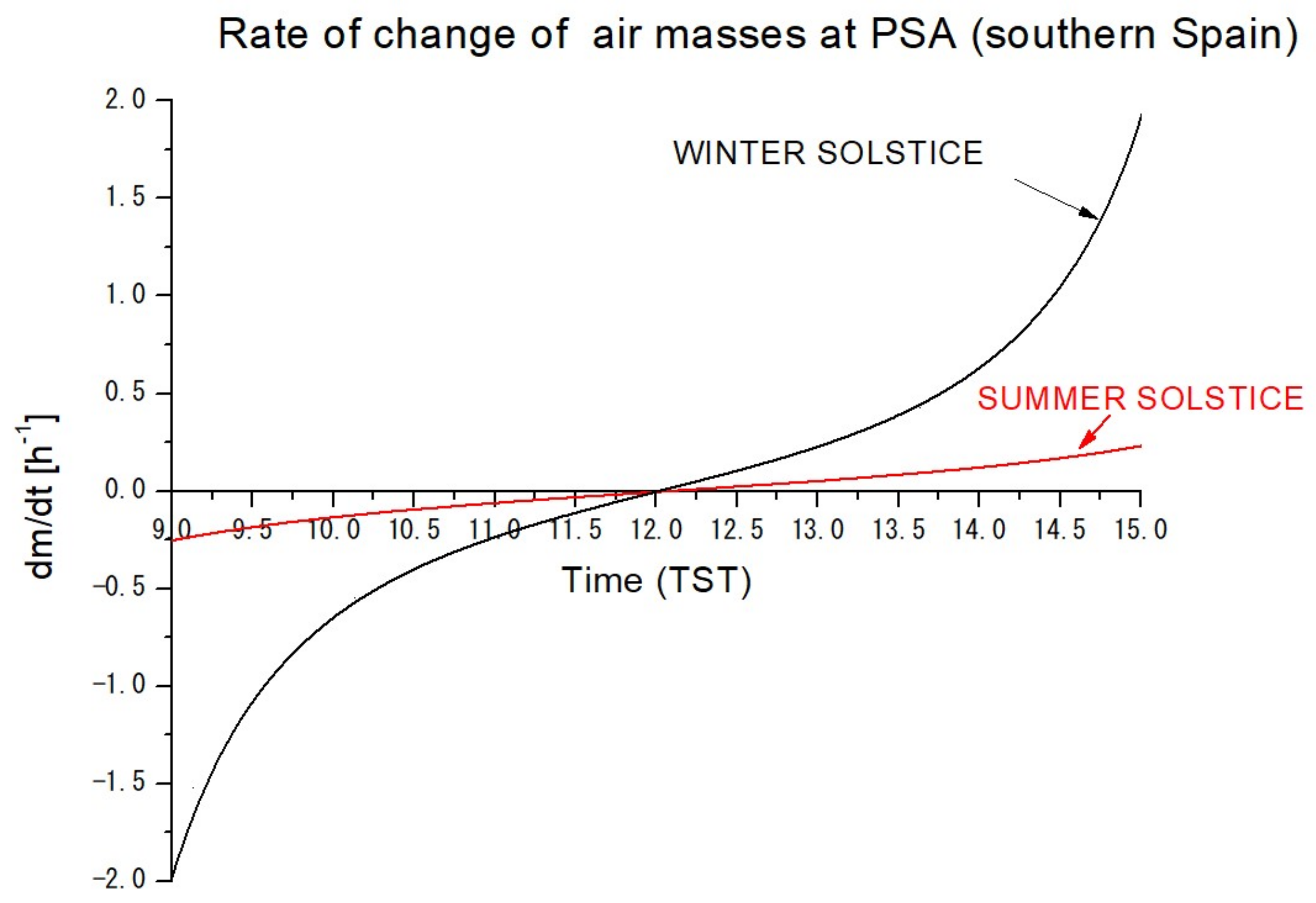
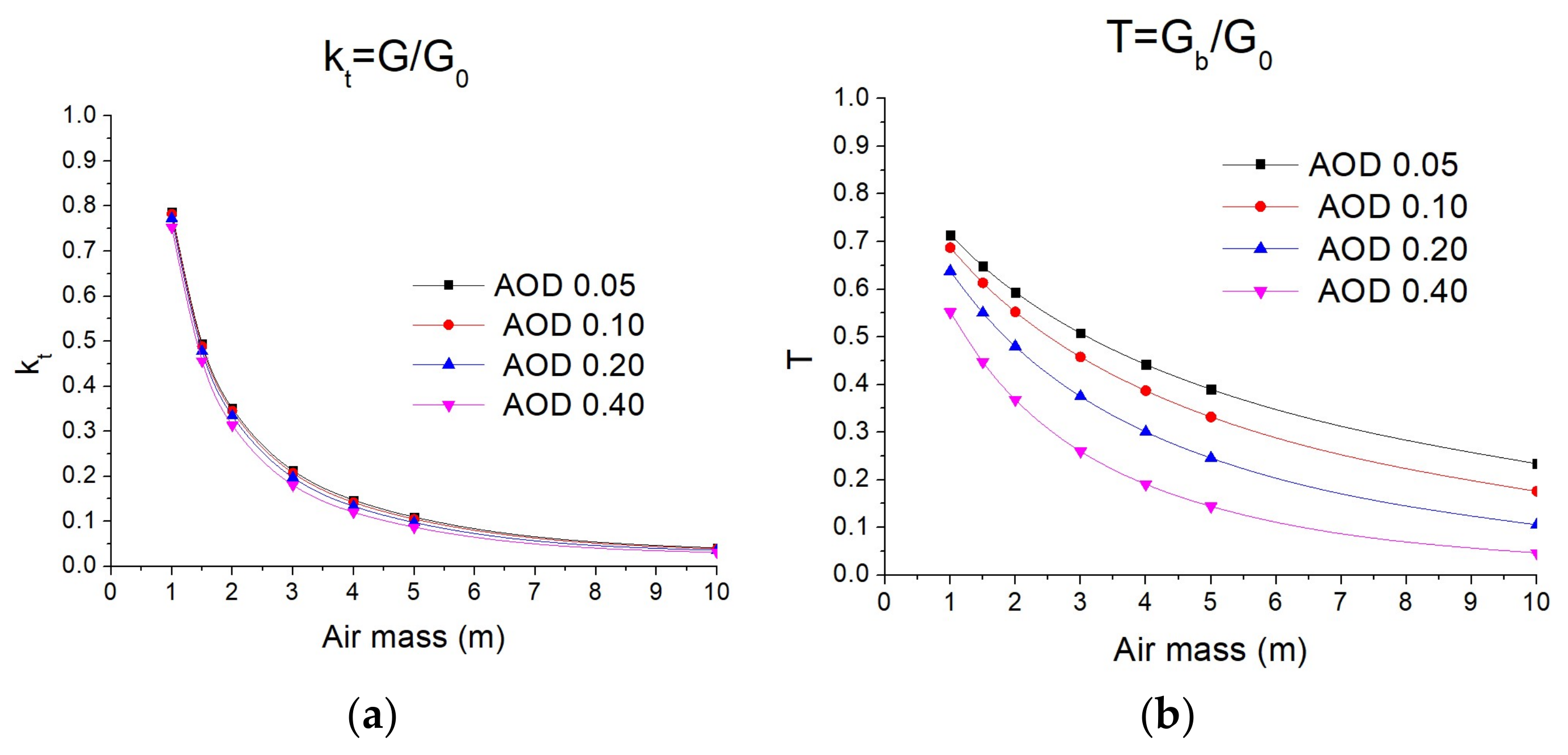
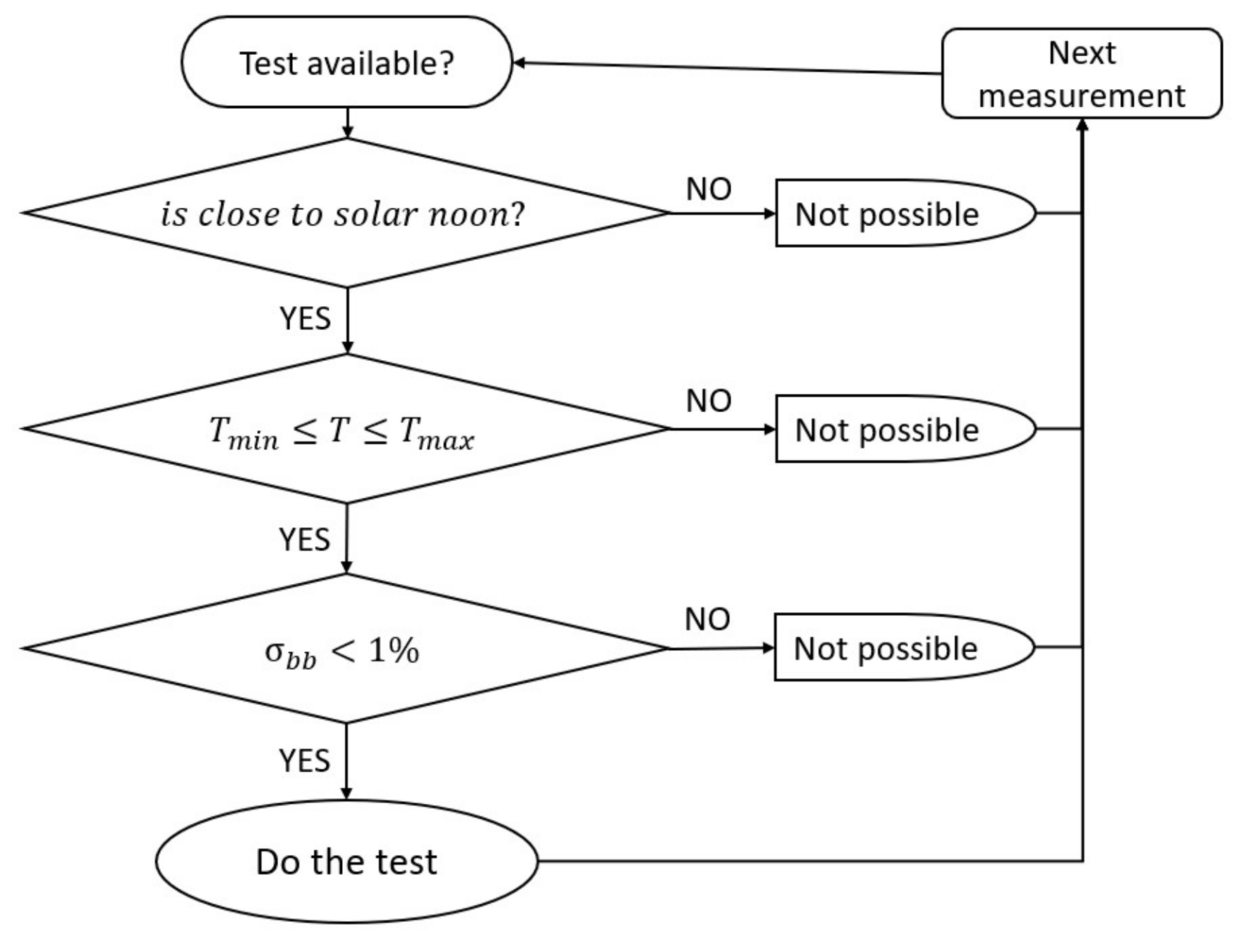

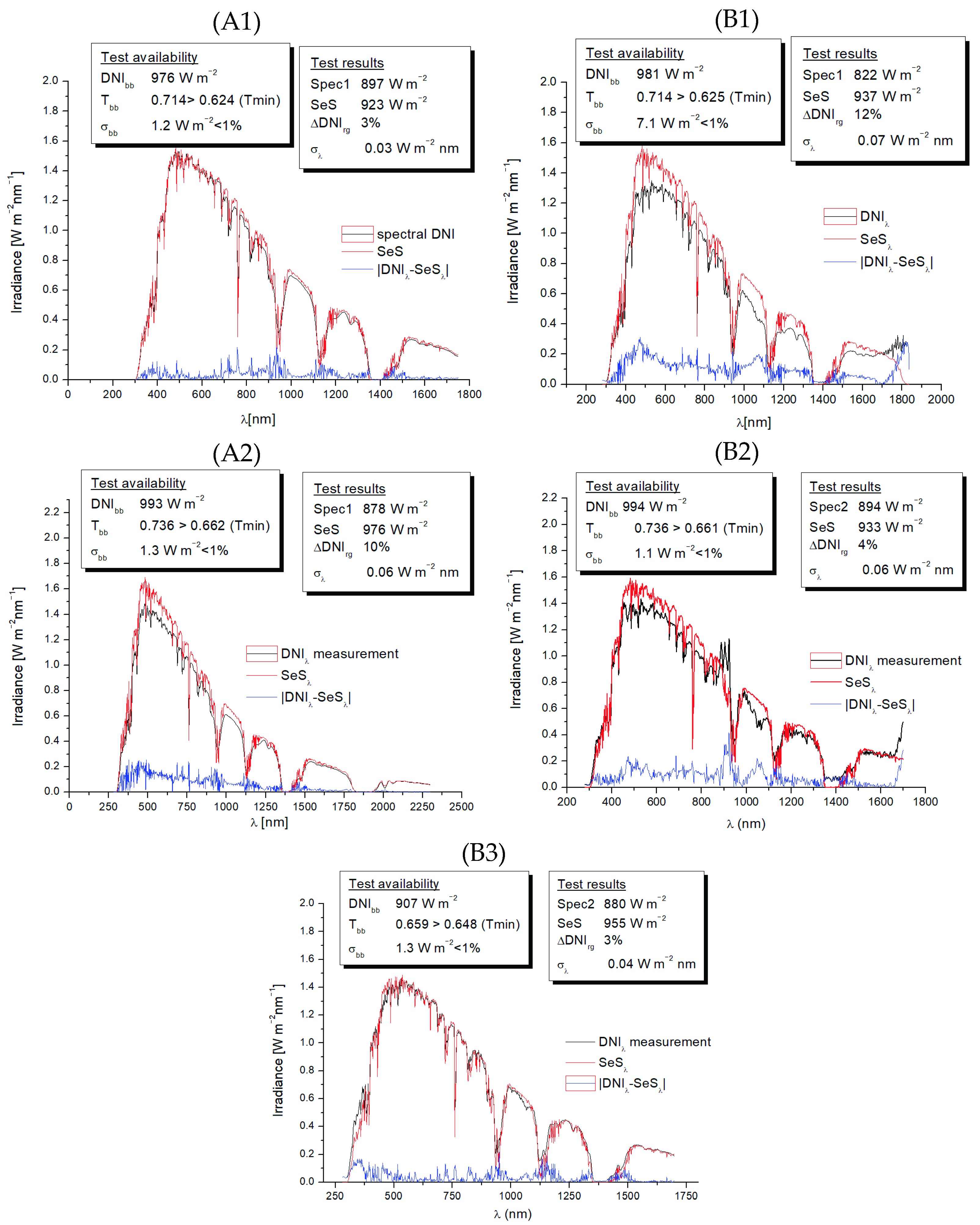
| Variable | Units | Values | ||||
|---|---|---|---|---|---|---|
| Minimum | Reference | Maximum | No Steps | |||
| Site pressure (At 505 masl) a | mb | 1000 a | 1013.25 | 1030 a | 16 | |
| Water vapor | cm | 1 | 3 | 4.8 | 20 | |
| Ozone (at sea level) | atm-cm | 0 | 0.3 | 0.6 | 21 | |
| Gaseous Abs and pollution b | -- | Severe Pollution b | Moderate Pollution b | Light Pollution b | 3 | |
| CO2 | ppmv | 330 | 370 | 500 | 18 | |
| Aerosol model b | -- | Maritime | Rural | Tropospheric | Urban | 4 |
| Atmosphere turbidity (AOD at 500 nm) | -- | 0 | 0.084 | 1 | 21 | |
| Albedo | -- | 0 | 0.2 | 1 | 10 | |
| Earth–Sun distance | AU | 0.997 | 1.0 | 1.003 a | 7 | |
| Solar constant, G0 | W m−2 | 1367 | 1367 | 1367 | 1 | |
| Air mass | 1 | 1.5 | 20 | 25 | ||
| SPECTRAL RANGE | (280–4000) | (280–2500) | (280–1750) | (280–1150) | (400–850) |
|---|---|---|---|---|---|
| 2.80% | 2.78% | 2.75% | 2.84% | 2.77% |
Publisher’s Note: MDPI stays neutral with regard to jurisdictional claims in published maps and institutional affiliations. |
© 2021 by the authors. Licensee MDPI, Basel, Switzerland. This article is an open access article distributed under the terms and conditions of the Creative Commons Attribution (CC BY) license (https://creativecommons.org/licenses/by/4.0/).
Share and Cite
Marzo, A.; Ballestrín, J.; Alonso-Montesinos, J.; Ferrada, P.; Polo, J.; López, G.; Barbero, J. Field Quality Control of Spectral Solar Irradiance Measurements by Comparison with Broadband Measurements. Sustainability 2021, 13, 10585. https://doi.org/10.3390/su131910585
Marzo A, Ballestrín J, Alonso-Montesinos J, Ferrada P, Polo J, López G, Barbero J. Field Quality Control of Spectral Solar Irradiance Measurements by Comparison with Broadband Measurements. Sustainability. 2021; 13(19):10585. https://doi.org/10.3390/su131910585
Chicago/Turabian StyleMarzo, Aitor, Jesús Ballestrín, Joaquín Alonso-Montesinos, Pablo Ferrada, Jesús Polo, Gabriel López, and Javier Barbero. 2021. "Field Quality Control of Spectral Solar Irradiance Measurements by Comparison with Broadband Measurements" Sustainability 13, no. 19: 10585. https://doi.org/10.3390/su131910585
APA StyleMarzo, A., Ballestrín, J., Alonso-Montesinos, J., Ferrada, P., Polo, J., López, G., & Barbero, J. (2021). Field Quality Control of Spectral Solar Irradiance Measurements by Comparison with Broadband Measurements. Sustainability, 13(19), 10585. https://doi.org/10.3390/su131910585










